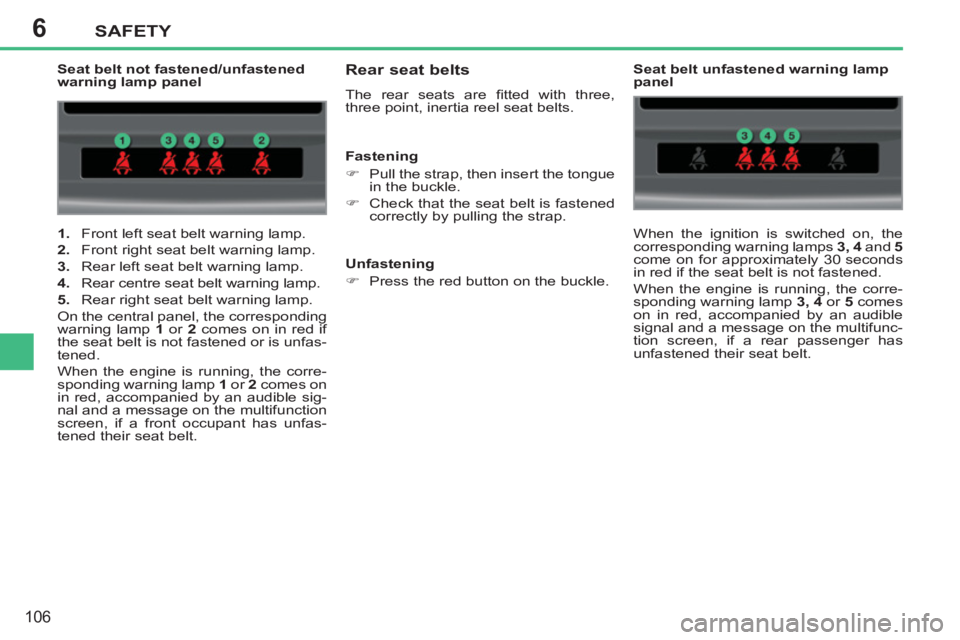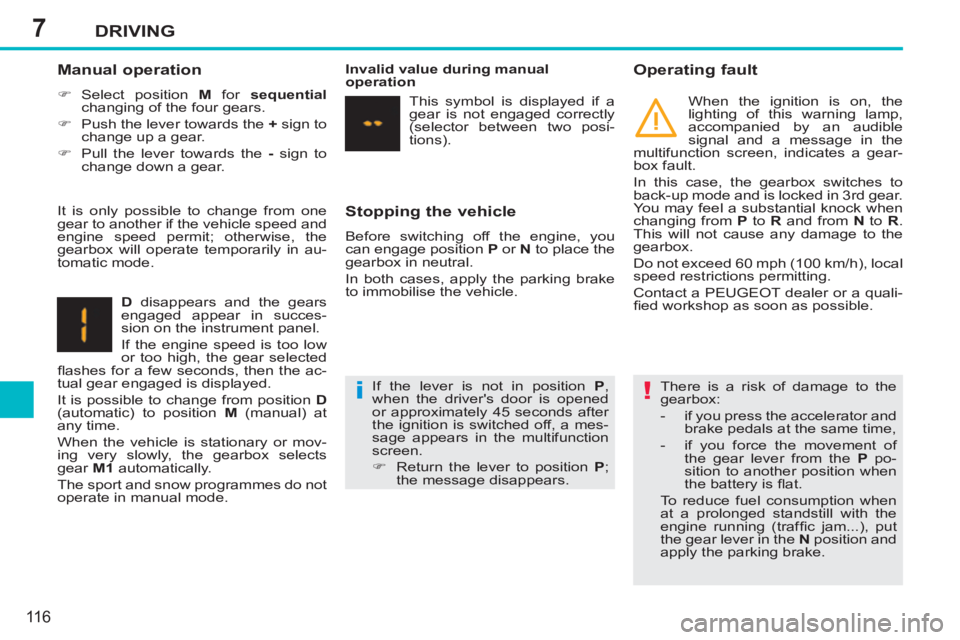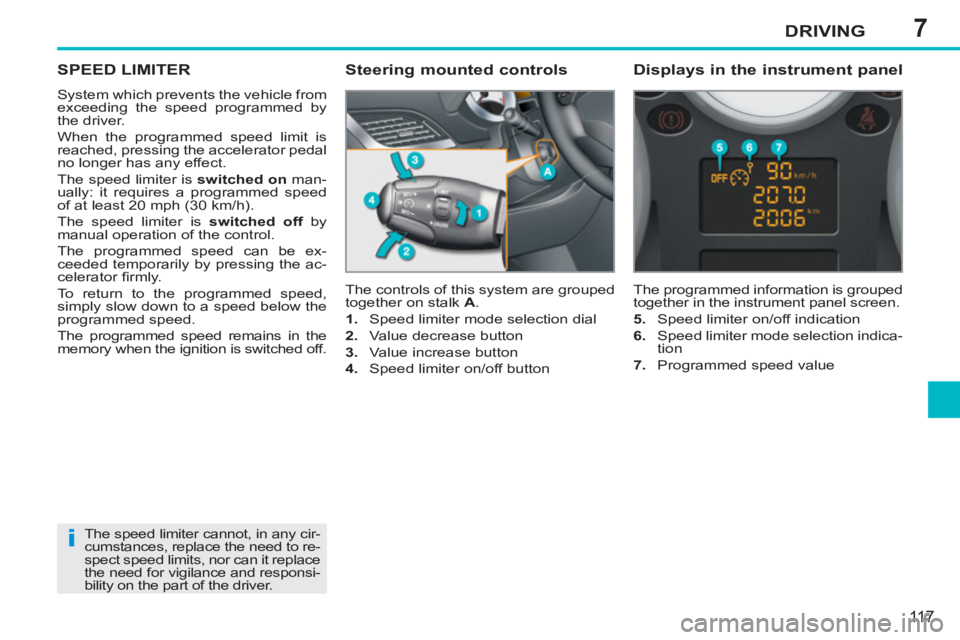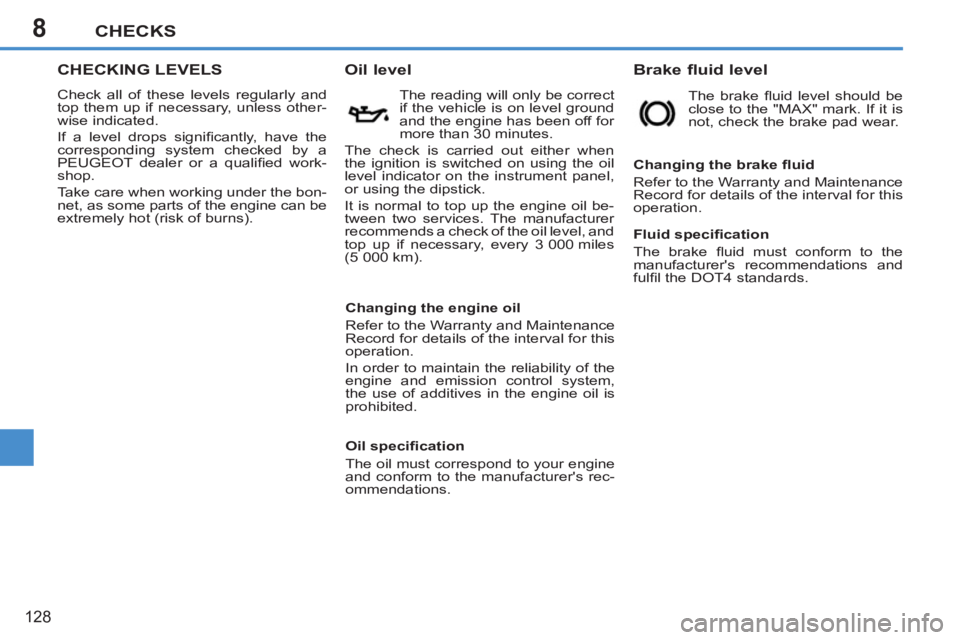2011 PEUGEOT 207 ignition
[x] Cancel search: ignitionPage 108 of 248

6SAFETY
106
1.
Front left seat belt warning lamp.
2.
Front right seat belt warning lamp.
3.
Rear left seat belt warning lamp.
4.
Rear centre seat belt warning lamp.
5.
Rear right seat belt warning lamp.
On the central panel, the corresponding
warning lamp 1
or 2
comes on in red if
the seat belt is not fastened or is unfas-
tened.
When the engine is running, the corre-
sponding warning lamp 1
or 2
comes on
in red, accompanied by an audible sig-
nal and a message on the multifunction
screen, if a front occupant has unfas-
tened their seat belt.
Seat belt not fastened/unfastened
warning lamp panel
Rear seat belts
The rear seats are fi tted with three,
three point, inertia reel seat belts.
Seat belt unfastened warning lamp
panel
When the ignition is switched on, the
corresponding warning lamps 3, 4
and 5
come on for approximately 30 seconds
in red if the seat belt is not fastened.
When the engine is running, the corre-
sponding warning lamp 3, 4
or 5
comes
on in red, accompanied by an audible
signal and a message on the multifunc-
tion screen, if a rear passenger has
unfastened their seat belt.
Fastening
�)
Pull the strap, then insert the tongue
in the buckle.
�)
Check that the seat belt is fastened
correctly by pulling the strap.
Unfastening
�)
Press the red button on the buckle.
Page 110 of 248

6
i
!
SAFETY
108
AIRBAGS
The airbags do not operate when
the ignition is switched off.
This equipment will only operate
once. If a second impact occurs (dur-
ing the same or a subsequent acci-
dent), the airbag will not operate.
Front airbags
System which protects the head and
chest of the driver and front passenger
in the event of a front impact.
The driver's airbag is fi tted in the centre
of the steering wheel; the front passen-
ger's airbag is fi tted in the dashboard
above the glove box.
Operation
The airbags are deployed simultane-
ously, unless the passenger's front
airbag is deactivated, in the event of a
serious front impact applied to all or part
of the front impact zone A
, in the lon-
gitudinal centreline of the vehicle on a
horizontal plane and directed from the
front to the rear of the vehicle.
The front airbag infl ates between the
front occupant of the vehicle and the
dashboard to cushion their forward
movement.
Impact detection zones
A.
Front impact zone.
B.
Side impact zone.
Deployment of the airbag(s) is ac-
companied by a slight emission of
harmless smoke and a noise, due to
the activation of the pyrotechnic car-
tridge incorporated in the system.
This smoke is not harmful, but sen-
sitive individuals may experience
slight irritation.
The noise of the detonation may
result in a slight loss of hearing for
a short time.
System designed to maximise the safety
of the occupants (with the exception of
the rear centre passenger) in the event
of violent collisions. It supplements the
action of the force-limiting seat belts.
If a collision occurs, the electronic de-
tectors record and analyse the front and
side impacts sustained in the impact
detection zones:
- in the case of a serious impact, the
airbags are deployed instantly and
protect the occupants of the vehicle
(with the exception of the rear centre
passenger); immediately after the
impact, the airbags defl ate rapidly
so that they do not hinder visibility
or the exit of the occupants,
- in the case of a minor or rear impact
or in certain roll-over conditions, the
airbags will not be deployed; the
seat belt alone is suffi cient to pro-
vide optimum protection in these
situations.
Page 111 of 248

6
!
!
SAFETY
109
If both airbag warning lamps come
on continuously, do not install a
"rear facing" child seat on the front
passenger seat.
Have it checked by a PEUGEOT
dealer or a qualifi ed workshop.
Operating fault
If this warning lamp comes on in
the instrument panel, accompa-
nied by an audible warning and
a message in the multifunction
screen, contact a PEUGEOT dealer or a
qualifi ed workshop to have the system
checked. The airbags may no longer be
deployed in the event of a serious impact. To assure the safety of your child,
it is imperative that the passen-
ger's airbag is deactivated when
you install a "rear facing" child seat
on the front passenger seat.
Otherwise, the child would risk be-
ing seriously injured or killed if the
airbag were deployed.
According to version, this warn-
ing lamp comes on either in the
instrument panel or in the central
panel when the ignition is on and
until the airbag is reactivated.
Reactivation
When you remove the child seat, turn
switch 1
to the "ON"
position to reacti-
vate the airbag and so assure the safety
of your front passenger in the event of
an impact.
Deactivation
Only the front passenger's airbag can
be deactivated:
�)
with the ignition off
, insert the key
in the passenger airbag deactivation
switch 1
,
�)
turn it to the "OFF"
position,
�)
then, remove the key keeping the
switch in the new position.
Page 118 of 248

7
i!
DRIVING
116
Stopping the vehicle
Before switching off the engine, you
can engage position P
or N
to place the
gearbox in neutral.
In both cases, apply the parking brake
to immobilise the vehicle.
Operating fault
When the ignition is on, the
lighting of this warning lamp,
accompanied by an audible
signal and a message in the
multifunction screen, indicates a gear-
box fault.
In this case, the gearbox switches to
back-up mode and is locked in 3rd gear.
You may feel a substantial knock when
changing from P
to R
and from N
to R
.
This will not cause any damage to the
gearbox.
Do not exceed 60 mph (100 km/h), local
speed restrictions permitting.
Contact a PEUGEOT dealer or a quali-
fi ed workshop as soon as possible.
There is a risk of damage to the
gearbox:
- if you press the accelerator and
brake pedals at the same time,
- if you force the movement of
the gear lever from the P
po-
sition to another position when
the battery is fl at.
To reduce fuel consumption when
at a prolonged standstill with the
engine running (traffi c jam...), put
the gear lever in the N
position and
apply the parking brake.
Manual operation
�)
Select position M
for sequential
changing of the four gears.
�)
Push the lever towards the +
sign to
change up a gear.
�)
Pull the lever towards the -
sign to
change down a gear.
D
disappears and the gears
engaged appear in succes-
sion on the instrument panel.
If the engine speed is too low
or too high, the gear selected
fl ashes for a few seconds, then the ac-
tual gear engaged is displayed.
It is possible to change from position D
(automatic) to position M
(manual) at
any time.
When the vehicle is stationary or mov-
ing very slowly, the gearbox selects
gear M1
automatically.
The sport and snow programmes do not
operate in manual mode. If the lever is not in position P
,
when the driver's door is opened
or approximately 45 seconds after
the ignition is switched off, a mes-
sage appears in the multifunction
screen.
�)
Return the lever to position P
;
the message disappears.
It is only possible to change from one
gear to another if the vehicle speed and
engine speed permit; otherwise, the
gearbox will operate temporarily in au-
tomatic mode.
Invalid value during manual
operation
This symbol is displayed if a
gear is not engaged correctly
(selector between two posi-
tions).
Page 119 of 248

7
i
DRIVING
11 7
SPEED LIMITER
System which prevents the vehicle from
exceeding the speed programmed by
the driver.
When the programmed speed limit is
reached, pressing the accelerator pedal
no longer has any effect.
The speed limiter is switched on
man-
ually: it requires a programmed speed
of at least 20 mph (30 km/h).
The speed limiter is switched off
by
manual operation of the control.
The programmed speed can be ex-
ceeded temporarily by pressing the ac-
celerator fi rmly.
To return to the programmed speed,
simply slow down to a speed below the
programmed speed.
The programmed speed remains in the
memory when the ignition is switched off. The controls of this system are grouped
together on stalk A
.
1.
Speed limiter mode selection dial
2.
Value decrease button
3.
Value increase button
4.
Speed limiter on/off button
The programmed information is grouped
together in the instrument panel screen.
5. Speed limiter on/off indication
6. Speed limiter mode selection indica-
tion
7. Programmed speed value
Steering mounted controls
Displays in the instrument panel
The speed limiter cannot, in any cir-
cumstances, replace the need to re-
spect speed limits, nor can it replace
the need for vigilance and responsi-
bility on the part of the driver.
Page 121 of 248

7
i
DRIVING
119
CRUISE CONTROL
System which automatically maintains
the speed of the vehicle at the value
programmed by the driver, without any
action on the accelerator pedal.
The cruise control is switched on
manually: it requires a minimum vehicle
speed of 25 mph (40 km/h), as well as
the engaging of:
- fourth gear on a manual gearbox,
- second gear on an automatic gear-
box in sequential mode,
- position D
on an automatic gear-
box.
The cruise control is switched off
man-
ually or by pressing the brake or clutch
pedal or on triggering of the ESP sys-
tem for safety reasons.
It is possible to exceed the programmed
speed temporarily by pressing the ac-
celerator pedal.
To return to the programmed speed,
simply release the accelerator pedal.
Switching off the ignition cancels any
programmed speed value. The controls of this system are grouped
together on stalk A
.
1.
Cruise control mode selection dial
2.
Value decrease button
3.
Value increase button
4.
Cruise control off/resume button
The programmed information is
grouped together in the instrument pan-
el screen.
5.
Cruise control off/resume indication
6.
Cruise control mode selection indi-
cation
7.
Programmed speed value
Steering mounted controls
Displays in the instrument panel
The cruise control cannot, in any cir-
cumstances, replace the need to re-
spect speed limits, nor can it replace
the need for vigilance and responsi-
bility on the part of the driver.
You are advised to keep your feet
near the pedals at all times.
Page 124 of 248

7
i
i
i
DRIVING
122
Deactivation/Activation of the rear
parking sensors
Operating fault
In bad weather or in winter, ensure
that the sensors are not covered
with mud, ice or snow. When re-
verse gear is engaged, an audible
signal (long beep) indicates that
the sensors may be dirty.
When the vehicle is moving at a
speed below 6 mph (10 km/h), cer-
tain sound sources (motorcycle,
lorry, pneumatic drill, etc.) may trig-
ger the audible signals of the park-
ing sensor system.
In the event of a malfunction of
the system, when reverse gear
is engaged this warning lamp
is displayed in the instrument
panel and/or a message appears in the
screen, accompanied by an audible sig-
nal (short beep).
Contact a PEUGEOT dealer or a qualifi ed
workshop.
The status of the function is stored
when the ignition is switched off.
For more information on access to
the parking sensors menu, refer to
the section covering the confi gura-
tion of vehicle systems.
The function will be deactivated au-
tomatically if a trailer is being towed
or a bicycle carrier is fi tted (vehicle
fi tted with a towbar or bicycle car-
rier recommended by PEUGEOT).
The function is deactivated
or activated via the vehicle
confi guration menu.
Page 130 of 248

8CHECKS
128
CHECKING LEVELS
Check all of these levels regularly and
top them up if necessary, unless other-
wise indicated.
If a level drops signifi cantly, have the
corresponding system checked by a
PEUGEOT dealer or a qualifi ed work-
shop.
Take care when working under the bon-
net, as some parts of the engine can be
extremely hot (risk of burns).
Brake fluid level
Oil level
The reading will only be correct
if the vehicle is on level ground
and the engine has been off for
more than 30 minutes.
The check is carried out either when
the ignition is switched on using the oil
level indicator on the instrument panel,
or using the dipstick.
It is normal to top up the engine oil be-
tween two services. The manufacturer
recommends a check of the oil level, and
top up if necessary, every 3 000 miles
(5 000 km). The brake fl uid level should be
close to the "MAX" mark. If it is
not, check the brake pad wear.
Changing the brake fl uid
Refer to the Warranty and Maintenance
Record for details of the interval for this
operation.
Changing the engine oil
Refer to the Warranty and Maintenance
Record for details of the interval for this
operation.
In order to maintain the reliability of the
engine and emission control system,
the use of additives in the engine oil is
prohibited.
Oil specifi cation
The oil must correspond to your engine
and conform to the manufacturer's rec-
ommendations.
Fluid specifi cation
The brake fl uid must conform to the
manufacturer's recommendations and
fulfi l the DOT4 standards.